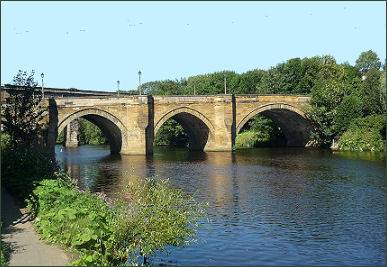Yarm
OS grid reference:-
 The small and characterful town of Yarm lies on the on the south bank of the River Tees and is situated on the northern border of North Yorkshire. The River Leven, a tributary of the Tees, lies to the east of the town.
The small and characterful town of Yarm lies on the on the south bank of the River Tees and is situated on the northern border of North Yorkshire. The River Leven, a tributary of the Tees, lies to the east of the town.
 The town's name is said to derive from the Old Norse word yarum which means an enclosure to catch fish or alternatively it may have developed from the Anglo-Saxon gearum which had the same meaning.
The town's name is said to derive from the Old Norse word yarum which means an enclosure to catch fish or alternatively it may have developed from the Anglo-Saxon gearum which had the same meaning.
The first written reference to Yarm occurs in the Domesday Survey of 1086, the settlement appears to have originally been a chapelry in the Kirklevington parish. In about 1286, Domninican Friars, commonly known as Black Friars, settled in Yarm and maintained a Friarage and a Hospital in the town, which survived until 1583.
Walter Skirlaw, Bishop of Durham (died 1406) built a stone bridge across the River Tees in 1400 , which still stands today . An iron replacement was built in 1805, but it fell down in 1806. A remarkable feat of engineering, Yarm Viaduct cost just £44,500 to build in 1848 and is 760 yards long. It was built to extend the Leeds and Thirsk Railway from Northallerton to Stockton and Hartlepool. With the river Tees flowing beneath it, the viaduct took a staggering seven and a half million bricks to construct.
The town hall on High Street dates to 1710 and was built by Thomas Belasyse who was Lord of the Manor. In a poll taken for the BBC's Breakfast programme on 19 January 2007, Yarm's High Street was voted the "Best High Street". The characterful street with its cobbled parking areas is fronted by many Georgian-style old buildings, with distinctive red pantile roofs. With an abundance of boutiques, specialist food suppliers, fashion and home interiors shops, Yarm offers one of the best selections of independent shops in the North East. There are numerous quaint wynds and alleys to explore just off the High Street.
The parish church of St Mary Magdalene is the third church to occupy its site. The first was a wooden Saxon building of which no traces remain. This was replaced by a Norman church in the late twelfth Century which remained until 1728 when it was burned down. The present Georgian church was built from the remains of the second in 1730.
The earliest evidence of a church in Yarm is the Trumbert Shaft. The shaft part of an inscribed sandstone grave cross, it was discovered being used as a mangle weight in Yarm in 1877 by Canon Greenwell of Durham. The shaft is now kept in the library of Durham Cathedral and bears the inscription:-
+ [orate] PRO [tru]MBERENCT + SAC+ ALLA + SIGNUM AEFTER HIS BREODERA YSETAE
Which translates as: Pray for Trumberhet, Bishop Alla set up this memorial to his brother Trumbert or Trumberhet was consecrated as Bishop of Hexham in AD 681, he was succeeded in AD 684 by Eata. The date of his death is not known, but clearly he was buried at Yarm late in the seventh or early in the eighth century.
The west end and the base of the tower of the present building are part of the original stone church which was built by the De Brus family, ancestors of King Robert the Bruce, in the latter half of the twelfth century. A fortified tower was added in the thirteenth century and rebuilt during the seventeenth century. In 1728, when the Norman church was badly damaged by fire, King George II allowed collections to be made at churches throughout England to help finance the rebuilding, something that proved so successful that the rebuilding was completed by 1730 using much of the stone from the earlier building. In 1878 the church was enlarged and restored by Lancaster architects Paley and Austin.
The Rookery, a public open space by the River is Tees situated at the bottom of Goose Pasture. The ash, sycamore and lime woodland is about 200 years old and owned by Yarm Town Council. In 2002 a walkway was constructed around the wood to celebrate the Golden Jubilee of Queen Elizabeth II.
